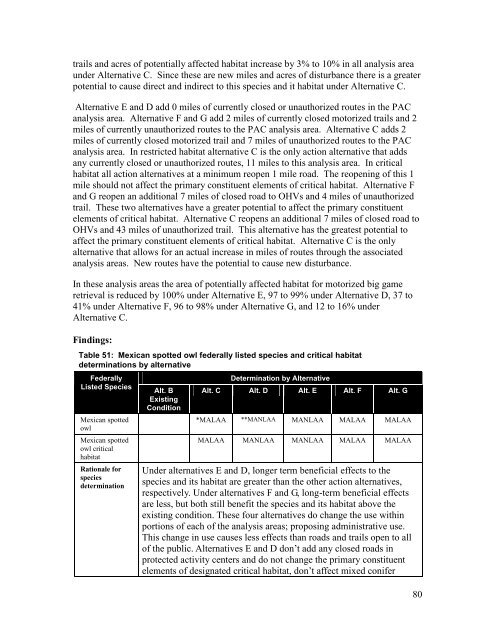Wildlife Specialist report
Wildlife Specialist report
Wildlife Specialist report
Create successful ePaper yourself
Turn your PDF publications into a flip-book with our unique Google optimized e-Paper software.
trails and acres of potentially affected habitat increase by 3% to 10% in all analysis area<br />
under Alternative C. Since these are new miles and acres of disturbance there is a greater<br />
potential to cause direct and indirect to this species and it habitat under Alternative C.<br />
Alternative E and D add 0 miles of currently closed or unauthorized routes in the PAC<br />
analysis area. Alternative F and G add 2 miles of currently closed motorized trails and 2<br />
miles of currently unauthorized routes to the PAC analysis area. Alternative C adds 2<br />
miles of currently closed motorized trail and 7 miles of unauthorized routes to the PAC<br />
analysis area. In restricted habitat alternative C is the only action alternative that adds<br />
any currently closed or unauthorized routes, 11 miles to this analysis area. In critical<br />
habitat all action alternatives at a minimum reopen 1 mile road. The reopening of this 1<br />
mile should not affect the primary constituent elements of critical habitat. Alternative F<br />
and G reopen an additional 7 miles of closed road to OHVs and 4 miles of unauthorized<br />
trail. These two alternatives have a greater potential to affect the primary constituent<br />
elements of critical habitat. Alternative C reopens an additional 7 miles of closed road to<br />
OHVs and 43 miles of unauthorized trail. This alternative has the greatest potential to<br />
affect the primary constituent elements of critical habitat. Alternative C is the only<br />
alternative that allows for an actual increase in miles of routes through the associated<br />
analysis areas. New routes have the potential to cause new disturbance.<br />
In these analysis areas the area of potentially affected habitat for motorized big game<br />
retrieval is reduced by 100% under Alternative E, 97 to 99% under Alternative D, 37 to<br />
41% under Alternative F, 96 to 98% under Alternative G, and 12 to 16% under<br />
Alternative C.<br />
Findings:<br />
Table 51: Mexican spotted owl federally listed species and critical habitat<br />
determinations by alternative<br />
Federally<br />
Listed Species<br />
Mexican spotted<br />
owl<br />
Mexican spotted<br />
owl critical<br />
habitat<br />
Rationale for<br />
species<br />
determination<br />
Alt. B<br />
Existing<br />
Condition<br />
Determination by Alternative<br />
Alt. C Alt. D Alt. E Alt. F Alt. G<br />
*MALAA **MANLAA MANLAA MALAA MALAA<br />
MALAA MANLAA MANLAA MALAA MALAA<br />
Under alternatives E and D, longer term beneficial effects to the<br />
species and its habitat are greater than the other action alternatives,<br />
respectively. Under alternatives F and G, long-term beneficial effects<br />
are less, but both still benefit the species and its habitat above the<br />
existing condition. These four alternatives do change the use within<br />
portions of each of the analysis areas; proposing administrative use.<br />
This change in use causes less effects than roads and trails open to all<br />
of the public. Alternatives E and D don’t add any closed roads in<br />
protected activity centers and do not change the primary constituent<br />
elements of designated critical habitat, don’t affect mixed conifer<br />
80
















